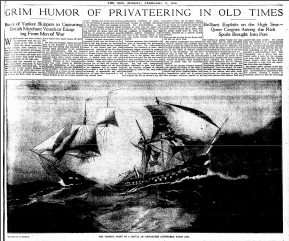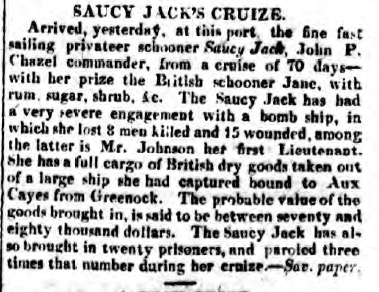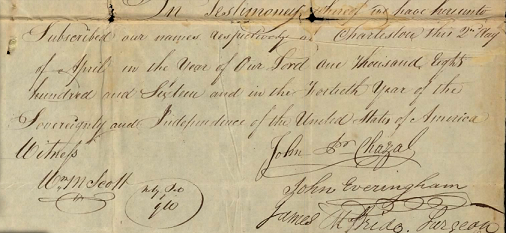Everingham Family History Record Reprint... (c)2014The "SAUCY JACK"
An Everingham owned
American Privateer Schooner
 | The New York SUN, 1913
Article about privateers of 100 years ago,
with information about the Saucy Jack. |
Legal Pirates in the WAR of 1812...
The Privateer Schooner named "SAUCY JACK" had a 90 foot deck, 24 foot beam, and displaced 170 tons. It boasted from 6 to 13 guns at various times throughout the War of 1812.
Her 3rd commission list shows she had nine, 12-pounder guns and a crew of 150. By some of it's logs it is known to have utilized two long-guns.
The Charleston-based privateer was launched with fanfare on Aug. 6, 1812 by the Pritchard and Shrewbury yard on the Cooper River under Capt. Thos. Jervey. The American Watchman Newspaper of Wilmington Deleware recorded the launch of the beautiful privateer ship "Saucy Jack" and said it was ready for sea at Charleston. By far the most successful of the privateers that sailed for Charleston in the war of 1812, the 6-gun schooner was painted black with a white streak along her side to distinguish her. Her first impressive capture was the brig William Rathbone which had fourteen guns and a cargo worth 40,000 pounds. That ship was intercepted and taken by another en-route to Charleston. One capture of the Saucy Jack was a little sloop known as Brothers. It made it back to Charleston. After one cruise with 3 captured vessels, Capt. Peter Sicard took command on October 31st for the second cruise where 4 vessels were captured. In December 1812, in company with the privateer Two Brothers of New Orleans, the Saucy Jack took the brig Antrim. The two privateers, still in company on January 19th, took the ship Mentor. Both prizes reached New Orleans safely and were reported worth about $150,000. In September, 1812, Sicard brought two prizes (captured vessels) into St. Mary's, Georgia, and then headed to Charleston. On the way home she encountered the Spanish ship LaVicente which had ten long guns and fourty men who mistakenly started an attack. The fight was stopped and only two men were wounded but the Saucy Jack reached Charleston April 12, 1813. In Charleston Sicard left the Jack and command was given to it's most renown Captain John P. Chazal in April, 1813. Among the 150 crewmen, he brought Lt. Dale Carr, second Lieutenant Lewis Jantzen and ship's surgeon, Dr. James McBride with him. Chazal, Jantzen & McBride had formerly led the crew of the Defiance. Captain Chazal stayed with this command until the war's end in January, 1815.
The Saucy Jack and Chazal were a good pairing that proved to be profitable for it's Charleston based owner, merchant John Everingham. From 1800 to 1830 Census data of Charleston, South Carolina shows us that John Everingham and wife Rebecca resided there. City directories tell us that John was a merchant and court records indicate that he owned, or co-owned other ships. As an example; in an 1810 court case about the schooner "Doris," testimony suggested that John Everingham of Charlestown was the sole owner of that ship. There were issues with a crew not quickly returning from leave in March 1813 as noted in a newspaper in Louisiana where they said "Notice to the men on leave from the privateer schooner Saucy Jack that unless they returnto their duty onboard before 12 o'clock on the 6th, they will be considered as desserters, and forfeit their prize money accordingly. The public are cautioned against trusting any person for account of the said schooner." Potentially losing income from a tour would be a great loss to the sailors involved. By April 27 1813, a Hartford, Connecticut Newspaper reported that the Saucy Jack arrived at Charleston on the 12th, from a cruise of four months in which she captured vessels valued about 150,000 dollars. On the 5th of April off Havanna, the Saucy Jack engaged for an hour the Spanish ship, Le Vincente. The Spanish captain commenced the attack supposing the American to be a French privateer. In 1813 John Everingham was listed as co-owner with "John Sinclair" of the privateer ship "General Armstrong," according to court records, it was not the more famed New York ship of the same name. John Everingham was a co-signer (with Capt. Chazal & Dr. McBride) in 1816 for the disability paperwork of one of the seaman, John Baker of the Saucy Jack. The American Neptune, Peabody Museum of Salem notes that the Saucy Jack was owned by John Everingham of Charleston. We know, from cemetery records, that John died in 1831.
| The Argus Press, Albany, New York, November 1814 |  |
Much is known about the Saucy Jack from various records of the exploits of the vessel found in many American and English history books and war records. It was also featured in local newspapers (shown here).
A survivor of a captured ship reported in January 1814 - "we were boarded, she proved to be the privateer schooner Saucy Jack, Capt. John P. Chazel, on a cruise, 5 weeks out from Savannah. She had captured several prizes among which was the brig Sir John Sherbrooke, which had been boarded the same morning."
The Saucy Jack of Charleston, passed through several heated, severe combats. On April 30, 1814, in the Windward passage between Cuba and Santo Domingo, she met the British ship Pelham, a large vessel of five hundred and forty tons, and having a compliment of ten guns. Pelham was bound from London to Port au Price. The Pelham fought well, and the action reportedly lasted two hours at the end of which she was boarded. English records say that the Pelham's crew of forty men were overpowered by numbers, but resisted with a resolve that commanded the admiration of the victors. Both vessels reached Charleston safely, and the Saucy Jack at once set out again.
Captain Chazal's log on the taking of the Pelham: "In the act of boarding, Stephen Dunham, one of our seamen, was shot dead and our First Lieutenant, Dale Carr, mortally wounded while fighting on the enemy's deck. At the same time our second Lieutenant Lewis Jantzen and John St. Amand, Lieutenant of Marines, was severely wounded, together with 7 of our men. Making our loss 2 killed and nine wounded, 8 of which badly. On board the Pelham there were 4 killed and 11 wounded; among the latter, the Captain and his Chief Mate (since died)." When they reached Charleston on May 20th the City Gazette had this to say;
| "We hardly remember to have seen a finer ship than the Pelham; she is 540 tons, coppered to the bends, mouts ten 12-pound carronades and long 6's, and had a compliment of from 35 to 40 men. Her cabin is hung round with a great variety of large and elegant naval prints in rich gilt frames." |
The Jack had also taken a pipe organ and piano from the Pelham. It isn't hard to imagine the loud singing and celebratory atmospheres generated by musical accompaniment aboard the 24 by 90 foot deck of the privateer vessel. Scenes of singing straight from modern-day pirate movies likely couldn't compare to the crew of over 100 celebrating privateers! The famed Saucy Jack and it's regularly reported success' made seamen eager to serve aboard her. On July 21, 1814 the following notice appeared in a Charleston Newspaper; "The privateer schooner Saucy Jack opened a rendezvous yesterday at 11 o'clock, for the enlistment of her crew. Before 5 P.M. one hundred and thirty able-bodied seamen were shipped in six hours and ready to engage in the glories and dangers of an Atlantic cruise."
On August 9th she brought the ship Hoppett and the brig Eliza both with cargo of cotton to Savannah, Georgia. Saucy Jack also took the Kingston Packet which had a small brass gun on board. On October 31, 1814, about 1 am, being then off Cape Tiburon at the west end of Haiti, she sighted two vessels standing to the westward. Chase was made and an hour later the privateer opened fire. The strangers replied at the same time shortening sail, which slowed them down. This had to look ominous but the Saucy Jack continued onward perhaps thinking that the ships felt safe having their attacker outnumbered. At 6am, having arrived within a few hundred yards, the enemy were seen to be well armed but appeared not to be well manned, so they continued. It was discovered that one ship contained sixteen guns and the other eighteen, but this still did not deter the attackers. At seven, daylight properly lit the area, and the Saucy Jack began an engagement with the nearer ship and ten minutes later ran alongside her, ready to board. At this point, she was found to be full of British soldiers!
Captain Chazal broke off their attack quickly, and began a rare retreat. They were followed by an incessant fire of ship's guns and musketry. This awkward escape which brought the chance of a disabling shot, mowing down of crew and consequent capture, lasted an hour. The Volcano pursued for three miles but finally, the speed of the schooner Jack took her out of range. In this narrow escape, eight men were killed and fifteen wounded. To add, two cannon shots had hit the hull and rigging was shot up. It was afterwards ascertained that her opponent was captain Price aboard the Volcano, a bombship. It was convoying the transport Golden Fleece. On board the Volcano and escorted ship were two hundred and fifty musket armed troops. The Volcano lost an officer and two men killed, and two wounded. The Jack's now first Lieutenant Jantzen was wounded, having recently recovered after taking the Pelham. The event was a narrow escape for the privateer and proved that under even the most awkward circumstances, the Saucy Jack could give as well as take.
Savannah was a regular return port and was a safe haven for the Jack and her crew. While there on Sept. 20, 1814, the Jack's fore-mast was struck by lightening and the bolt exited out the stern. After repairs, she continued in the West Indies and on November 6th, She had captured eight prizes, for one of which, the ship Amelia she had to fight vigorously, killing four and wounding five of the enemy, while herself sustaining a loss of one killed and one wounded. Chazal decided to take the most valuable cargo aboard which was lucky, because a few days later, Amelia had to be abandoned and burned. On November 28 she arrived at Savannah with the schooner Jane filled with rum, sugar, and dry goods from Amelia. That prize was said to be worth between seventy and eighty thousand dollars.
The Saucy Jack was among the most successful privateer ships of the south. In Georgia and South Carolina, the Saucy Jack was a source of local pride. She returned to Charleston on New Year's Eve. News of the peace reached Charleston in February of 1815 and the Jack then became a merchant ship. Her captures, engagements with foreign ships, and narrow escapes were unparalleled with any Southern privateer.
 | S. Carolina Disability claim Affidavit from the War of 1812
This document states that seaman John Baker formerly of the "Saucy Jack,"
privateer vessel, was severely wounded in February of 1814. It is signed
by the Ships former captain; John Chazal, owner: John Everingham, and
the ship's surgeon; Dr. James McBride. Document signed in 1816. |
|